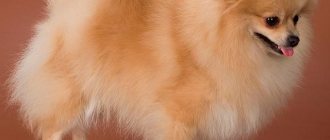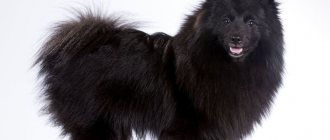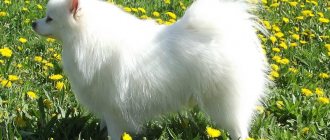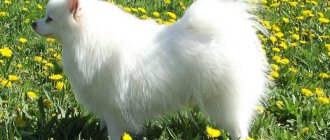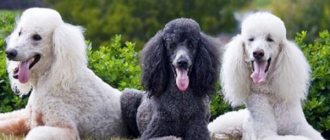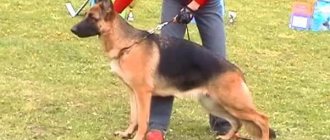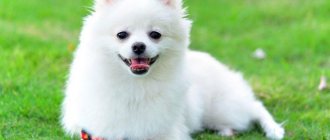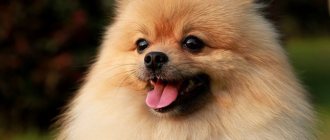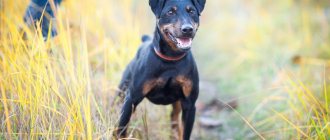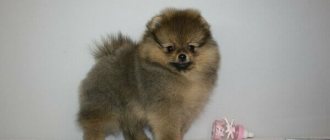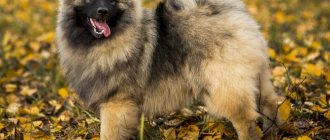The Greater German Spitz, or Grossspitz, is one of the largest species in its group. This is evidenced by the prefix “gross”. His appearance attracts attention with his unusually thick and beautiful fur, magnificent mane, and fluffy tail. In addition to attractive external characteristics, the dog is distinguished by high intelligence and trainability; it becomes not only a true friend, but also a reliable guard for the whole family. To raise a healthy pet, you should know the characteristics of the breed, methods of care, education, feeding and training.
Origin of the Greater German Spitz
The history of the large Gross Spitz dates back to the times of the Vikings, who appeared in Germany along with the massive northern dogs. Animals have long been used in Europe as shepherds and guards. From the mid-eighteenth century, breeders began working on the breed; the Spitz was reduced in size and the requirements for their weight were tightened. At the end of the nineteenth century, a Spitz breed club was founded in Germany, the standard of which was developed and approved by the FCI in 1906. Six species, differing in color and size, were combined into a group. The smallest among them is the Pomeranian, the largest is the Keeshond. The Grossspitz is the second largest and very rare representative of the breed, and therefore desirable and in demand by dog breeders.
Character traits
White Pomeranians can look cute and even defenseless. But, in fact, these dogs are characterized by such traits as activity, energy and courage.
They are sociable, positive and sociable, and they also love to run and play.
Spitz are friendly towards other animals and love children as long as they are not too pestered or teased.
IMPORTANT!
However, if there is no socialization or training, their character can deteriorate. This is why it is unacceptable to deprive White Pomeranians of physical or mental exercise, especially since these dogs are very smart and love to learn.
Description of the breed
A luxurious dog with beautiful fur, erect ears, a playful look and a good-natured character - that's what the big German Spitz is all about. He is comfortable living both in an apartment and in the yard, in an enclosure. During the period when the temperature drops to -20 ⁰C, the dog must be moved to a warm room.
With constant care and proper physical activity, Gross Spitz dogs grow healthy and rarely get sick. Quick wits, kindness and intelligence are qualities of large German Spitz dogs that allow them to be successfully kept in the family. Dogs are curious, active, but tolerant of children's pranks, so they get along well with them, guard and protect.
Breed standards
According to the standards, the Large German Spitz has the following characteristics:
- The ratio of body proportions is 1:1 (body length to height at withers).
- The head is wedge-shaped and has an elongated shape.
- The ears are pointed at the ends, erect, close to each other.
- The nose is small, round, black.
- The lips are tight-fitting, without folds at the corners.
- The jaws are well developed and have a straight or scissor bite.
- The cheekbones are prominent and rounded.
- The eyes are medium-sized, almond-shaped, and the eyelids are dark.
- The neck is of medium length, with a curved scruff and a voluminous woolen collar.
- The back is straight, the croup is wide, the loin is short and strong.
- The chest is developed, deep, with convex costal arches.
- The stomach is moderately tucked.
- The coat is thick, with a voluminous undercoat.
- The tail is pubescent, of medium length, strongly curved towards the back.
- The forelimbs are straight, widely spaced, with pronounced muscles on the shoulder blades. The hindquarters are muscular, with strong pubescence.
- The gait is free, flexible, springy, with a powerful push.
Eurasier
The Eurasier is an artificially created breed of dog. The first nursery was opened in 1971. The authorship belongs to Julius Wipfel and Charlotte Baldamus. According to generally accepted international standards, a Eurasian must have:
- weight from 23 to 32 kg;
- height from 48 to 60 cm (males are larger);
- wide head;
- a flat forehead with a leathery fold that makes the dog seem gloomy;
- wide mouth with black edging around the lips;
- straight, triangular ears;
- big eyes;
- straight back with well-defined withers;
- raised belly;
- strong body;
- a large fluffy tail curled like a donut;
- tall and thick limbs.
Important! The coat color can be any, with the exception of pure white. Until the first molt, the color is not considered fully defined. The coat color of an adult dog is a couple of shades lighter or darker.
Eurasians love long walks, playing ball, and attention from the owner. This is a companion dog, it will not make a guard.
Eurasians on a walk
Adult dog sizes
Large German Spitz dogs have a dry, strong constitution, and body proportions are close to square. The ratio of the length of the muzzle to the head is 2:3. Sexual dimorphism regarding the size of German Pomeranians is moderately expressed. An adult male has a height at the withers of 48-50 cm and a weight of about 20 kg. The female weighs on average 18 kg, height – 42-44 cm.
Spitz varieties
German Pomeranians contain several subspecies based on height:
- Wolfspitz (Keeshond) are the largest representatives of the breed, with a height of up to 55 cm, the predominant coat color is zone-gray.
- Grossspitz (large German Spitz) - height at the withers - up to 50 cm, main color - black, brown and white.
- Mittelspitz are medium-sized German Pomeranians, height - up to 38 cm, varied in color (white, gray, orange, black).
- Kleinspitz are small dogs (up to 29 cm), coat color varies.
- Miniature Spitz are the smallest (about 20 cm at the withers), color from snow-white to coal-black.
Grossspitz are quite difficult to distinguish from Wolfspitz. They are equally large, with lush hair and strong bones. You can identify a large German Spitz by its color. It comes in black, white or brown, while the Wolfspitz is wolf-like, with a characteristic dark mask on the face. Owners of German Pomeranians note that, unlike the good-natured Gross Spitz, Keeshonds are aggressive towards others.
Three colors of fluffiness
Spitz are distinguished by a magnificent double “coat”, consisting of a long outer coat and a dense, fluffy “collar” - the undercoat. The latter feels much softer than the rest of the wool. The shortest hairs, velvety in structure, are found on the head, ears, and the front side of the paws. The longest hair abundantly covers the tail and hind legs to the middle, forming “pants.”
The standard allows three coat colors of the German Spitz: completely black, brown of varying intensity, pure white. Any stains on a solid color are a defect.
Photos of different types of Spitz
Popular colors
The coat of large German Spitz dogs consists of two layers - a straight outer guard hair and a soft, voluminous undercoat. On the ears, head, and front of the legs it is short and velvety. There is a collar on the neck, the back of the legs from the croup to the hock and the tail are bushy. The most popular colors of Grossspitz are white, charcoal and brown. The large black Pomeranian has dark skin, a nose and a coat without any markings. Brown dogs have an even chocolate color, the same nose and dark eyes. Large white Spitz dogs are not allowed to have a yellowish coating or spots, which are most often found on the ears.
Dog character and behavior
The large German Spitz treats people with boundless devotion, is ready to be nearby in any situation - plays with children, calmly runs alongside when the owner is riding a bicycle or just walking. It's nice to go hiking with him or watch TV at home. The large German Pomeranian is friendly and sensitive; on an intuitive level, he senses his owner’s bad mood and does everything to correct it. The dog easily finds a common language not only with small children, but also with animals - cats, hamsters, birds. True, when the owner comes into contact with them, he becomes jealous.
Despite their friendliness and lack of aggressiveness, large German Spitz dogs are brave and courageous. Dogs constantly monitor the behavior of strangers; at the first danger they will notify you with a loud bark.
If the owner is not at home, the Grossspitz may refuse to comply with the demands and orders of other family members. The dog cannot tolerate communication in a raised voice, remembers the insult and stops trusting.
With proper upbringing, training and training, a large German Spitz is an absolutely adequate dog. She doesn’t pester people all the time and doesn’t demand every minute of attention, she plays or lies calmly, but at the same time she will happily support any endeavor.
Lifespan
Every owner of a large German Spitz strives to maintain the health of the pet and maximize its lifespan. The average duration is about 15 years. With proper care and proper diet, dogs over ten years old are energetic, cheerful, cheerful and may well become long-lived.
Despite their good health and immunity, large German Spitz dogs are prone to obesity and dental problems. The cause is lack of physical activity, unhealthy diet, pathologies of the gastrointestinal tract, lack of vitamins and microelements.
The peculiarity of the coat of an adult Gross Spitz is that with age its quality does not deteriorate, but becomes even better.
A touchy kind-hearted guy with a devoted heart
A large German Spitz can become a good, loyal friend in life. After all, he is able to endlessly love his owner and happily spend time with him and his family. The Grossspitz is always ready to run alongside you during a bike ride, take a quiet walk on a quiet evening, play for hours with children, or accompany you on a long hike or while watching TV.
Friendliness, energy and a kind heart do not exclude his courage and self-confidence. Spitz is an excellent guard, vigilantly monitoring the peace of his family and treating strangers with suspicion. With a loud bark he will notify you of any suspicious noise or guest. And if necessary, he will boldly face danger, covering his owner with his chest.
The Spitz is ready to be friends with any pets, especially if they grew up together. However, he may become jealous if the owner begins to devote more time to another pet. These dogs do not know how to live without their owner's attention. Forced loneliness has a negative impact on both the mental and physical state of the dog.
What is the difference between males and females of the Greater German Spitz breed?
Before purchasing a large German Spitz, you need to decide for what purpose it is being purchased. If you want to participate in exhibitions, you should opt for a male dog. There will be no problems with it during estrus, hormonal surges, unplanned pregnancies and difficult childbirth. When choosing a puppy for a family, it is worth purchasing a female. They are calmer, more obedient and friendlier than males. There are other differences between girls and Pomeranian boys:
- bitches are easy to train and do not require strict control;
- they have a less impressive appearance, so they rarely take part in exhibitions;
- they don’t try to dominate like males;
- more flexible;
- They are clean and do not mark their territory.
A large German Spitz male becomes a real guard for the family; he is able to rush to defense even if the forces are not equal. Bitches are more likely to be nannies for children than guards, although they protect them in case of danger no less fiercely.
What determines the cost of a dog?
Now I propose to talk about what you should focus on if puppy is what you need:
- First of all, of course, a good breeder’s prices cannot be low. They can even go up to $800! But, of course, this is not the case everywhere. However, a Grossspitz cannot be too cheap either - almost certainly such owners do not have all the necessary documents and a health record. And there are no guarantees, accordingly.
- But the Gross Spitz, by the way, costs less than the Pomeranian. And here the next point arises - fashion. Pomeranian “toy” Spitz were still more in demand both before and now. And I can’t shake the feeling that it will be the same in the foreseeable future.
- Compliance with standard. If the animal already has noticeable deviations from the norms, it will cost less. Of course, this does not in any way affect the qualities of a companion - such a dog will still be an excellent friend. However, it will not be possible to take it to exhibitions. However, not all owners strive.
- The next point is the floor. Girls have always been more expensive than boys. Simply because it is the young ladies who produce offspring. If the buyer wants to breed Spitz dogs in the future, he should take a closer look at the female and pay extra for such an investment.
Conditions of keeping and care of the Gross Spitz
The large German Spitz easily adapts to any conditions. The dog can be kept in an ordinary apartment, where he has a comfortable place with a bed, bowls for food and water. While the puppy is small, they use a small enclosure where the pet is placed while the owners are away.
In a country house, a large German Pomeranian feels great on the street if it has a walking area, a warm booth and a spacious enclosure with shelter from rain and sun. On the site you can provide a shower or a small pond for bathing the dog. In winter, in severe frosts, it must be transferred to a warm room.
Caring for your pet consists of regular walks, hygiene procedures, proper feeding, training and education. You need to take care of your health and get vaccinated in a timely manner.
Care for eyes, ears and claws
The ears of a large Spitz should be regularly cleaned of dirt using a napkin and cotton swabs dipped in boiled water or a special lotion. To avoid damaging the membrane, they should not be placed deep into the ear canal. If the ears become inflamed or there is discharge from them, you should consult a veterinarian for help.
The eyes are wiped daily with a cotton swab, removing dust or dirt that gets into them during walks and to get rid of tear tracks on the Spitz's face. In addition, you need to cut off the disturbing hairs near the eyes. Use scissors with rounded ends to avoid accidentally injuring the animal.
If the nails do not wear off during walks, they need to be trimmed, otherwise they get in the way, the dog begins to limp, and there is a high probability of developing joint disease. To avoid damaging living tissue, only the very ends are cut off using a nail clipper.
Grooming, haircut
The coat of a large German Spitz has the property of self-cleaning, so it is bathed with shampoo no more than once every three months. More frequent washing is harmful to the animal's skin, causing irritation and itching. The lower abdomen and paws are washed with clean warm water after each walk. To avoid colds, dry the wool thoroughly using a hairdryer.
Brush the dog at least twice a week, and daily during the molting period. Use a special anti-tangle spray, brushes, combs and combs. Most often they form in the armpits, genitals, ears and chest. If the tangles cannot be untangled, they are removed.
It is better to entrust the haircut of a large German Spitz to a professional groomer, since one accidental movement can disturb the undercoat, after which it is difficult for the coat to restore its original appearance.
Diet
The Greater German Pomeranian is a very active dog that requires a lot of energy. With natural feeding, the bulk of her diet is animal protein. The total daily amount of food for an adult pet is about two liters. It is divided into two doses, including in the diet 0.6 kg of vegetables and cereals, 0.5 kg of cottage cheese and kefir, 0.4 kg of offal or lean meat. Once or twice a week, meat is replaced with fish, and fruit is offered as a delicacy. You should not give sweets or baked goods; they are not intended for digestion by the dog’s gastrointestinal tract and can lead to obesity.
Grossspitz prefers oatmeal or buckwheat porridge, to which greens and eggs are added. A treat for him is a small bone.
Food should be fresh, prepared from quality products, water should be clean and always available.
Industrial food is selected from at least premium grade varieties; the dog should like their taste. For precise dosage and ease of feeding, it is worth purchasing an automatic feeder and an automatic drinking bowl.
Training and raising a dog
From the very first days, the puppy must be taught that the owner is the leader. You cannot achieve this by shouting or aggression; only affection and encouragement will help you achieve success in education and training. The large German Pomeranian is ready for it already at the age of four months - it perfectly assimilates new information and remembers commands. The process goes more successfully during the game, the puppy receives motivation, interest and desire to carry out the owner’s orders. To train your dog for protection, you should contact specialists at the canine service.
At the age of six months, more complex commands are available to the puppy, which need to be taught without nervousness, devoting about 15 minutes to each exercise. At the final stage, they come up with a game in which the dog will emerge victorious, which will serve as additional motivation and raise his self-esteem.
Diseases, timely vaccinations
Large German Spitz dogs have good health. They have virtually no genetic diseases, since the species has been less affected by selection than others. You need to pay attention to proper nutrition and physical activity to avoid allergic reactions and excess weight gain. It is equally important to vaccinate your dog in a timely manner and bring it to a veterinarian for preventive examinations.
The first complex vaccination is given at the age of 8-9 weeks, and it is repeated at 12 weeks. At six months, after changing teeth, the child is revaccinated and the rabies vaccine is added. Next, they are vaccinated against plague, parainfluenza, enteritis, leptospirosis, and hepatitis annually at the same time.
Two weeks before vaccination, dogs are wormed and treated for fleas and ticks. For 2-3 days, the German Pomeranian is limited in physical activity and body temperature is measured. Vaccination is postponed if painful symptoms are present.
At what age is mating, pregnancy and childbirth preferable?
You can breed a large German Spitz bitch at one and a half years old, but it is better to postpone pregnancy for another six months in order to observe the regularity of the dog's estrus.
Before mating, routine vaccination and deworming are required. The bitch is not fed before being brought into the dog's territory, but is given a walk. Pregnancy can be determined by changes in the female’s behavior - she becomes calmer, toxicosis is quite likely. The dog is transferred to three meals a day, leaving the portion size the same, and is walked at least three times a day without active movements and excessive physical activity.
Immediately before giving birth, the bitch becomes restless, her stomach drops, and her body temperature drops. Normally, labor lasts from 10 to 24 hours. They seek help from a veterinarian if it lasts more than a day.
A firm hand and clear instructions - no concessions
A supple sofa pet is not about large German Spitz dogs. Dogs of this breed are intelligent and quick-witted, thanks to which they are able to remember many commands and perform complex tasks. They can be trained not only in basic obedience and training, but also in performing interesting circus tricks.
But not everyone can cope with raising and training a Gross Spitz. His independence and stubbornness can infuriate any owner. Even one indulgence or expression of aggression can easily lead to a loss of control over the dog. To avoid this, you will have to stock up on patience and treats, with severity and perseverance, in a playful way to make him an obedient pet.
Now you understand what a Grossspitz is. If you want to share your knowledge with your friends, send them a link to this article and don't forget to like it.
What do you know about these dogs? Please tell us in the comments.
Advantages and disadvantages of a large dog
The large German Spitz is not only a beautiful dog with excellent coat, but also a true friend for the owner and family members. An adult German Pomeranian has other advantages:
- possibility of living in a city apartment and in a private country house;
- communication skills;
- kind attitude towards children;
- high intelligence and learning ability;
- devotion to the owner and family;
- unpretentiousness in care and living conditions;
- excellent immunity.
The disadvantages of the large German Spitz include:
- difficulty tolerating loneliness;
- tendency to jealousy;
- loud barking;
- the need for constant coat care;
- high cost of puppies.
Diseases
Good pet health is the result of proper care from the owners. To achieve this goal, not only the character and preferences of your pet are taken into account, but also the characteristics of its breed, such as:
- propensity to certain diseases;
- genetic predispositions;
- methods of prevention and treatment.
Despite the fact that Spitz dogs rarely get sick, this does not mean that diseases “pass them by.” Veterinarians name 4 main factors that can cause health problems in a Spitz:
- small sizes;
- structural features;
- genetic abnormalities;
- incorrect content.
But the main danger for the baby is the lack of attention to his charming person. The sociable character cannot stand loneliness. He, and only he, should be at the center of everything that happens. Otherwise - a spoiled mood, blues, which, over time, can develop into serious problems.
Let's consider these reasons and options for minimizing the consequences.
Spitz
Choosing a Gross Spitz puppy, cost in Russia and abroad
Before you buy a large German Spitz, you need to find a kennel. Choose a proven one with positive reviews and reputation. When examining the puppy, pay attention to the uniform color of the coat (any spot or blotch is a defect). It’s good if it’s fluffy and voluminous, without dents or bald spots. Behavior should be active and open to contact. A healthy Gross Spitz has a well-fed physique without prominent costal arches, no discharge from the eyes and ears, and a pink tongue and mouth. At two months of age, the baby's ears are erect. The puppy should move easily and smoothly; even slight lameness indicates joint pathology.
The Large German Spitz is a rare breed, one of the reasons is the low fertility of bitches. The cost of puppies in the Russian Federation is from 22,000 rubles to 60,000 rubles. The price varies significantly in different countries. In nurseries in Germany - about 1000 euros, in the Czech Republic - 500-700 dollars. The most expensive German Pomeranian is white.
Purchasing a puppy
Grossspitz is a rare breed, their small population affects the price of the puppy. The most expensive puppies are white dogs. When purchasing a puppy, you need to consider the possibility of transporting the baby. Perhaps the puppy is thousands of kilometers from its future home, and the road will be long and tiring for a month-old baby. In this case, you can agree with the breeder to raise the puppy up to three or four months, then the dog will grow a little and the journey home will be more pleasant.
When buying an expensive animal, and the price of a puppy is from 30,000 rubles, it is necessary to conclude a purchase and sale agreement, read the documents for the producers, check the veterinary passport for vaccinations and collect the puppy’s birth certificate.
An external examination of the baby should show the absence of spots; Gross Spitz dogs are always one-color dogs. A dog's paws should have four toes. The stomach is not bloated, the back should not sag. The eyes and ears are clean, without discharge, the mouth and tongue are pink.
The puppy should be curious but careful. After he sniffs the stranger, he may show joy and offer to play. If after the first sniff the puppy tucks its tail and runs away or barks intermittently, then it is better to refuse to buy a cowardly puppy, because cowardice is a breed defect.
Photo of the most expensive of the Grossspitz - white
How to choose your future pet?
White Pomeranian puppies look so cute and adorable that it can be very difficult to resist buying the first one you see.
And yet, before going for a future pet, you need to choose a nursery or private breeder as carefully as possible. It should be taken into account that the puppy’s parents must belong to a healthy line. Of course, the baby himself must also be completely healthy and have a stable psyche.
The show titles of ancestors are important only when you plan to buy a breed or show class baby, while a pet class puppy simply must be healthy and come from parents who have received permission for breeding.
NOTE!
When choosing a white Pomeranian, you need to take into account that it must come from pure white dogs and there should not be ancestors of a different color in its pedigree.
